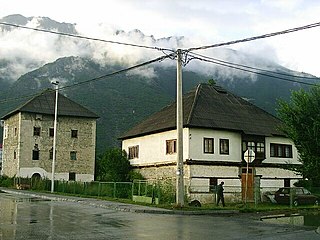
Ulcinj is a town in the Coastal region of Montenegro and the capital of Ulcinj Municipality. It has an urban population of 11,488.

Gusinje is a small town in Montenegro in the northern region. According to the 2011 census, the town has a population of 1,673 and is the administrative center of Gusinje Municipality.

The Zeta Banovina, was a province (banovina) of the Kingdom of Yugoslavia between 1929 and 1941. This province consisted of all of present-day Montenegro as well as adjacent parts of Central Serbia, Croatia, Kosovo and Bosnia and Herzegovina. It was named after the Zeta River which also gave its name to the medieval state of Zeta that roughly corresponds to modern-day Montenegro. The capital of Banovina was Cetinje.

Ulcinj Municipality is the southernmost municipality of Montenegro, bordered by Albania to the east, Bar Municipality to the north and Adriatic Sea to the south and the west. It has an area of 255 km², and a population of 19,921 as of the 2011 census. Its seat is the town of Ulcinj.
Albanians in Montenegro are ethnic Albanians who constitute 4.91% of Montenegro's total population. They belong to the ethnic Albanian sub-group of Ghegs, and they are the largest non-Slavic ethnic group in Montenegro.

Islam in Montenegro refers to adherents, communities and religious institutions of Islam in Montenegro. It is the second largest religion in the country, after Christianity. According to the 2011 census, Montenegro's 118,477 Muslims make up 20% of the total population. Montenegro's Muslims belong mostly to the Sunni branch. According to the estimate by the Pew Research Center, Muslims have a population of 130,000 (20.3%) as of 2020.

Languages of Montenegro are languages that are spoken in Montenegro. According to the Constitution of Montenegro, adopted in 2007, Montenegro has only one official language, specified as Montenegrin. The Montenegrin language is written in the Latin and Cyrillic alphabets, but there is a growing political movement to use only the Latin alphabet.

The Sailors' Mosque is an important landmark in Ulcinj, Montenegro that once served as a lighthouse.

Pasha's Mosque is one of six mosques in the city of Ulcinj, in Montenegro.

The Ulcinj Castle or Ulcinj Old Town is an ancient castle and neighborhood in Ulcinj, Montenegro. Today it is mostly inhabited by Albanians, it was built by the Illyrians on a small peninsula at the right side of the Pristan Gulf, which is part of the Adriatic Sea. Today, oldest remains are the Cyclopean Wall. The castle has been restored many times since it was first built although major changes were made by the Byzantines, Serbs, Venetians, and Ottomans. The modern city of Ulcinj was built outside of this castle.

The Church-Mosque of Ulcinj, also called Imperial Mosque, Halil Skura Mosque, Kalaja Mosque or Church of St. Maria is a former church and mosque located in Ulcinj, Montenegro.
The Kryepazari Mosque, also called Majapazari Mosque is one of the six mosques in Ulcinj. It was built by Nuradin-Beg from Ulcinj in 1749. It was destroyed in the earthquake in 1979, and 16 years later it was renewed by the donations of the local people. The Friday Khutbah is given in Arabic and Albanian. To the complex of this mosque also belong the main office of the Islamic religious community of Ulcinj, a library and a kindergarten.
The Bregu Mosque is one of the six mosques in Ulcinj, Montenegro, and it is located in neighbourhood Meraja. It was built by captain Ahmet Gjyli from Ulcinj in 1783, near his own house. It was significantly damaged in the earthquake in 1979 and in 1986 was reconstructed. The Friday Khutbah is given in Arabic and Albanian.

The Namazgjahu Mosque, also called Big Mosque is one of the six mosques in Ulcinj, Montenegro, the biggest one.

The Clock Tower of Ulcinj, was built in Ulcinj, Montenegro in 1754 during the Ottoman Empire's rule over the city, with the help of donations made by the citizens of Ulcinj. The name comes from the Turkish Saat Kulesi which literally means "Clock Tower" in English.

Gëzim Hajdinaga is a Montenegrin-Albanian politician, former member of Democratic Union of Albanians.

Museum of Local History in Ulcinj or simply Museum of Ulcinj is a local museum located in Kalaja, part of Ulcinj, Montenegro.

Battle of Ulcinj took place between the Ottoman forces of Dervish Pasha and Albanian irregulars in the year of 1880 at the region of Kodra e Kuqe, close to Kllezna. The area of Plav and Gusinje had been ceded to Montenegro according to the Treaty of Berlin (1878), but the Albanians fought against the annexation. The Great Powers then persuaded the Ottomans to cede the area of Ulcinj, but the Albanians yet again refused. Eventually, the Great Powers commanded the Ottomans to take actions against the League of Prizren, ending the resistance and successfully handing over the town of Ulcinj to Montenegro.

Rizo Šurla, also known as Rizo Harapi, was a Montenegrin photographer, actor and anti-fascist fighter who fought in the ranks of the Yugoslav Partisans during World War II.

Fatmir Gjeka (Montenegrin: Fatmir Đeka; born 17 April 1975)is a Montenegrin politician. In Montenegro, he serves as Minister of Human and Minority Rights, Chairman of Democratic Party and he was Mayor of Ulcinj.




















